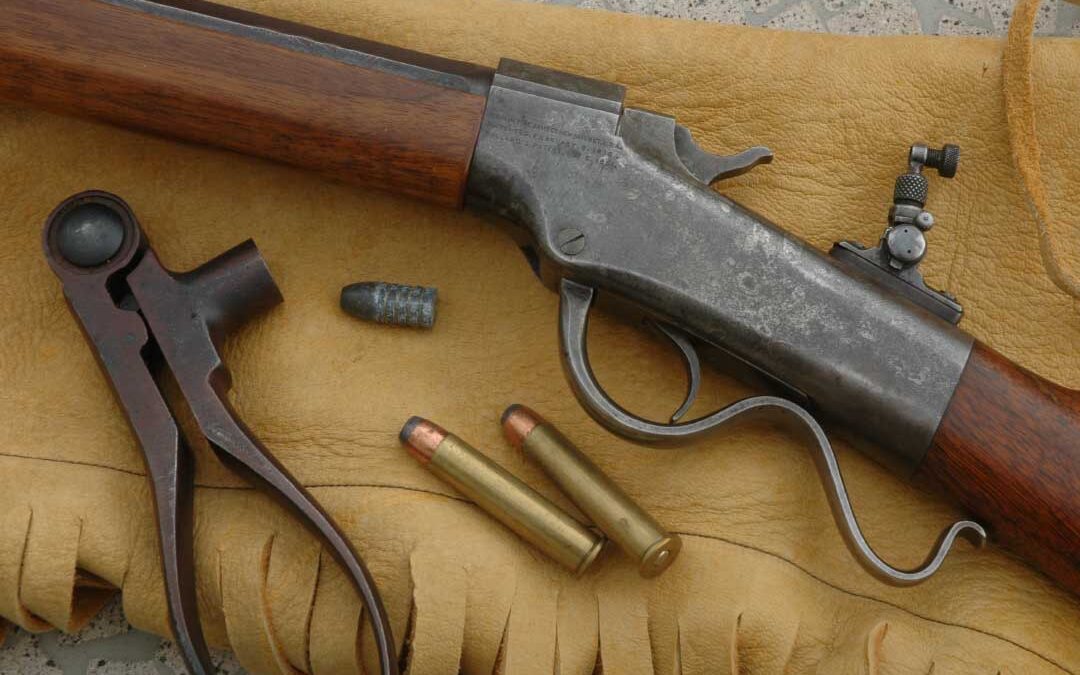In 1873, Henry McCarty had just turned 14. The next year his mother would die of tuberculosis. The year after that, he’d be collared for stealing clothes from a Chinese laundry. Soon thereafter he would leave New York City’s Irish slums and drift west. A man would fall to his bullet in an Arizona saloon in 1877. Under the alias William Bonney, then as Billy the Kid, he would kill 20 more.
 Not all that happened in ’73 made news. Some of what did faded behind the faces and fortunes of colorful characters then defining the frontier West. Outlaw John Wesley Hardin turned 20 that year, as did Indian scout and future lawman Bat Masterson. At 25, Wyatt Earp had three years on Doc Holliday, who with the Earps would face the Clanton-McLaurey gang at Tombstone’s OK Corral in 1881.
Not all that happened in ’73 made news. Some of what did faded behind the faces and fortunes of colorful characters then defining the frontier West. Outlaw John Wesley Hardin turned 20 that year, as did Indian scout and future lawman Bat Masterson. At 25, Wyatt Earp had three years on Doc Holliday, who with the Earps would face the Clanton-McLaurey gang at Tombstone’s OK Corral in 1881.
Belle Starr, rough of dress and manner, was 25 years old in 1873, Jesse James 26. John Selman, who would later kill Hardin in an El Paso saloon, was 33. The Dalton brothers (five of 15 children born to Adeline Younger, aunt to the Youngers of the James-Younger gang) were striplings in 1873. They’d gain notoriety two decades on, barely before citizen gunfire laid most of them low during a doomed attempt to rob two banks in Coffeyville, Kansas, October 5, 1892.
In the chaos of the day, actions of law officers could be hard to distinguish from those of outlaws. Whoever the combatants, bloodshed earned more headlines than did financial news.
But 1873 was also the year of a panic, a stock-market melt-down in Europe that quickly jumped the Atlantic. Speculative railroad investment after the Civil War stressed banks when, after 33,000 miles of new tracks in five years, loans were left hanging. Northern Pacific’s failure to pay back a $1.5 million debt set off a chain of bank crises and closed the New York Stock Exchange. Great fires in Chicago and Boston in 1871 and ’72 further drained banks. Reserves in New York fell from $50 million to $17 million during the fall of 1873. Rail strikes and a collapse in the timber market prolonged the panic. Replacement of the silver thaler with the gold mark in Europe’s German states affected the U.S. mining industry. By 1879, nearly a third of our nation’s railroads, and 18,000 businesses, had gone bankrupt.
Less dramatic and less worrying than most news of the day were the welcome announcements of two new rifle cartridges. In 1873 Winchester introduced an improved lever rifle to follow the Model of 1866, which had used a 44 Rimfire cartridge based on the Henry’s. (A stiffer 28-grain powder charge hurled 200-grain bullets faster.) The Model 1873 chambered a powerful centerfire cartridge, the company’s first. The 44 W.C.F., or 44-40, burned 40 grains of blackpowder to send a 200-grain bullet at 1,310 fps.
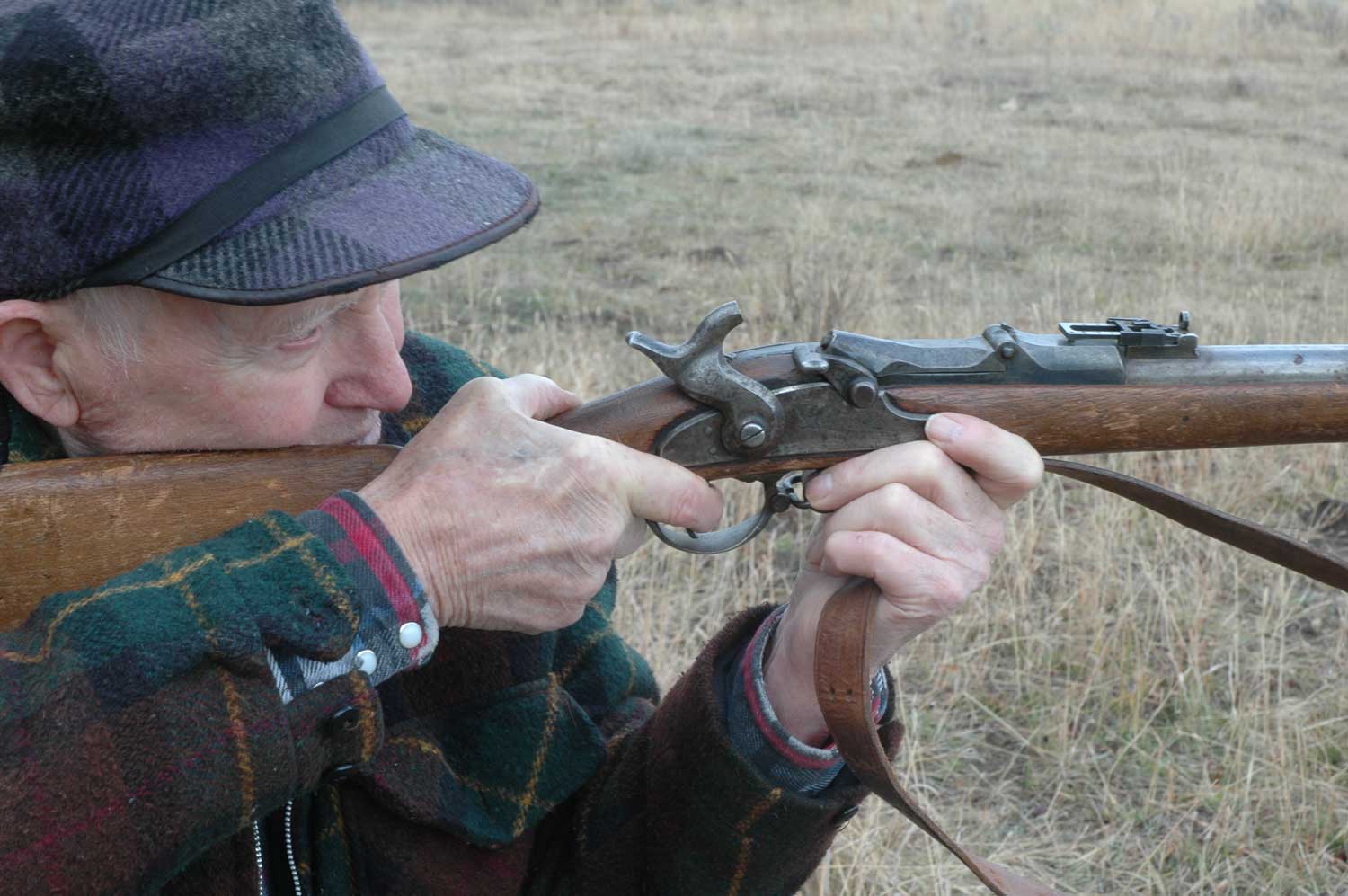
Early trapdoor Springfields in 50-70 (here) soon gave way to 45-70s, adopted by the Army in 1873.
The other cartridge to debut in 1873 was the 45-70 Government, for the trapdoor Springfield rifle recently adopted by the U.S. Army. During the Civil War, Union infantry fought mainly with front-loading rifles, named for the government armory in Springfield, Massachusetts. While their .58-caliber missiles could cause great damage, re-charging rifles during battle was both difficult and harrowing. Unless firing from distance or behind stone or earthen cover, the rifleman was exposed to ball, bayonet and rifle butt for long, terrifying seconds. Soldiers spilled powder and fumbled caps, even loaded charges backwards. Many recovered rifles were so disabled. Some had multiple charges stacked in their bores by soldiers so numbed by fear they didn’t think to fire.
Loading from the breech had clear advantages and made repeating mechanisms practical. Spencer and Henry rifles, used in limited numbers, impressed Union and Confederate troops. But replacing many thousands of muzzleloaders with any breechloader would incur huge costs. The Army demurred. Then it asked Springfield’s Erskine Allin to modify the existing 1861 Springfield breech to accept cartridges. In short order he designed a hinged breechblock. With the hammer to half-cock, actuating a thumb latch let the block spring up and ahead, like a trapdoor. The rising block activated the extractor, which kicked the case free. More complex than it looked, Allin’s conversion required 56 machining operations to produce, and $5 per rifle, installed. Allin improved it for the 1863 rifle. Barrels were reamed to .64-caliber, then fitted with iron sleeves bored for the centerfire 50-70 Musket round.
Late to Civil War campaigns, the trapdoor Springfield famously proved itself on August 2, 1867, on the prairie near Wyoming’s Fort Kearney. A large force of hostile Sioux swarmed a detachment of 26 soldiers and six civilians, whose only cover was overturned wagons. Furiously feeding Allin’s breech, the defenders repelled the attackers. The Wagon Box Fight spurred the Army to install trapdoor conversions on 55,000 new 1863 Springfields. Soon it abandoned the 50-70-450 cartridge (.50 caliber, 70 grains blackpowder, 450-grain bullet) for the 45-70-405. The new bullet left the muzzle at 1,320 fps with 1,570 ft.-lbs. of energy. A load with 55 grains of powder was issued to the cavalry, whose lightweight carbines might well be fired horseback. A Forager cartridge killed small game with birdshot launched in a wooden husk.
Long-range trials with 405- and 500-grain bullets in 45-70 Springfields were reported in 1880 by the office of the Secretary of War. With 70 or 80 grains of blackpowder, the heavy bullet had a ballistic edge—and, of course, imposed stiffer recoil. At 3,500 yards it spent 21 seconds aloft and descended nose first to penetrate three 1-inch planks. The Army issued 45-70-500 loads for its improved ’84 Springfield.
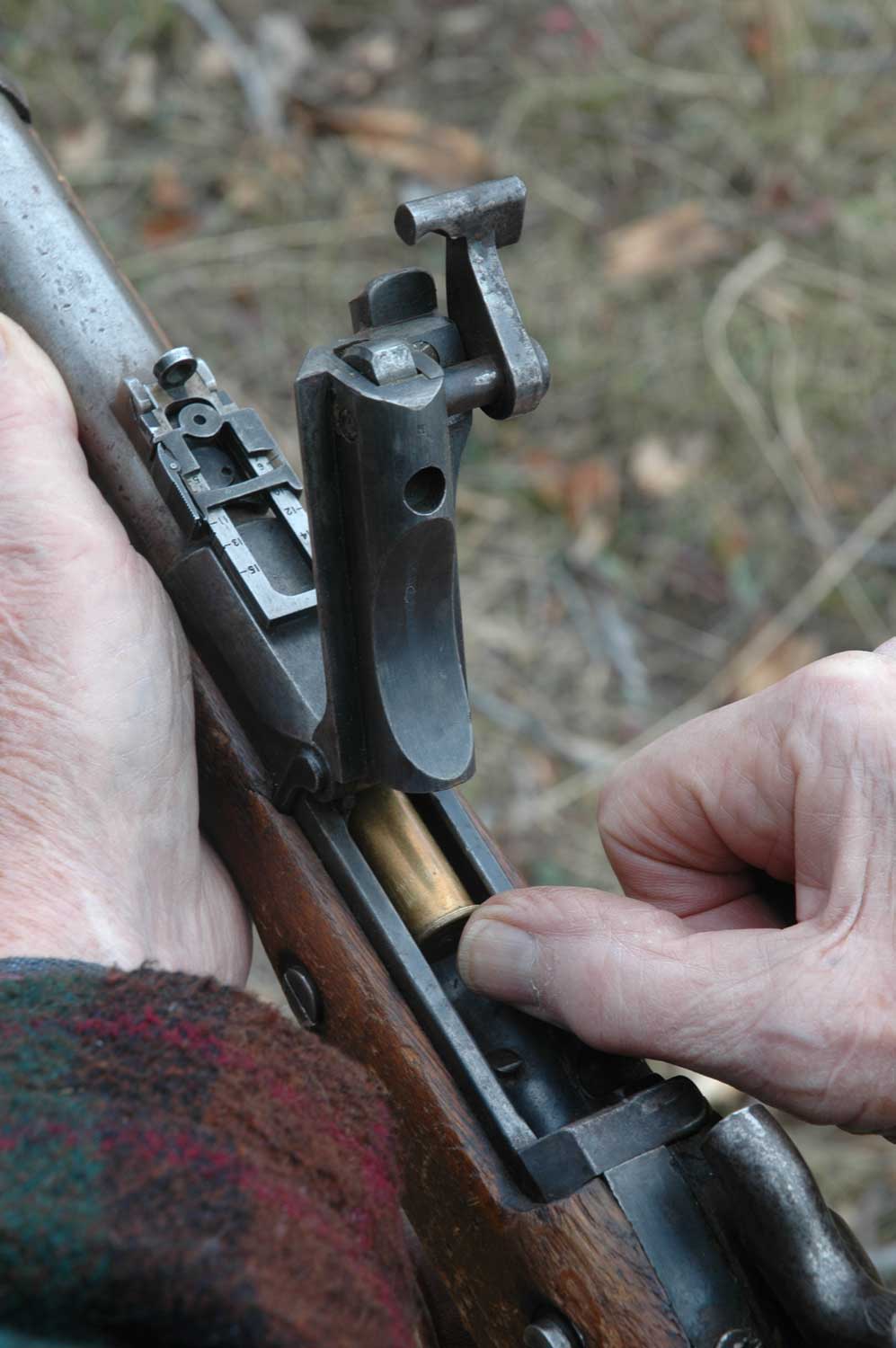
Erskine Allin’s pivoting breech block turned 1863 muzzleloaders into 1873 trapdoor Springfields.
Sharps percussion rifles were also converted to fire metallic cartridges. The 45-70 was a popular pick, though the New Model 1869 was also offered in 40/50, 40/70, 44/77 and 50/70. It preceded the New Model 1874 Sharps (introduced, oddly enough, in 1871), which soon buried it. The 1874’s tenure spanned 12 years, as hunters left millions of tons of bones bleaching in the sun where once dark seas of buffalo had covered the prairie. The “Old Reliable” Sharps was an archetype. A friend once inherited an excellent specimen and offered it to me at what I thought it was worth. In a painful fit of candor, I said it was worth more than I could pay without peddling my pickup and getting my wifeAlice a second job. He sold it in days for $9,000. Today it would bring considerably more.
After Christian Sharps died young of tuberculosis, the Sharps Rifle Manufacturing Co. served its faithful by chugging out single-shot rifles and big proprietary Sharps cartridges: six .40s, three .44s, four .45s, three .50s. The “Big 50” burned 90 to 110 grains of powder in a 2 1/2-inch case to drive a 473-grain paper-patched bullet at about 1,320 fps. (The more powerful 50-140 Sharps, with a 3 1/4-inch case, didn’t appear until 1880, when the great buffalo herds were in tatters, widely spaced and not profitable to hunt.) Sharps rifles were abandoned, sometimes smashed, by Indian warriors who’d killed their owners. Unless there was a ready supply of cartridges at hand, such a rifle was useless. Much preferred by hostiles were Winchesters and Springfields in 44-40 and 45-70, as that ammunition could be had just about anywhere.
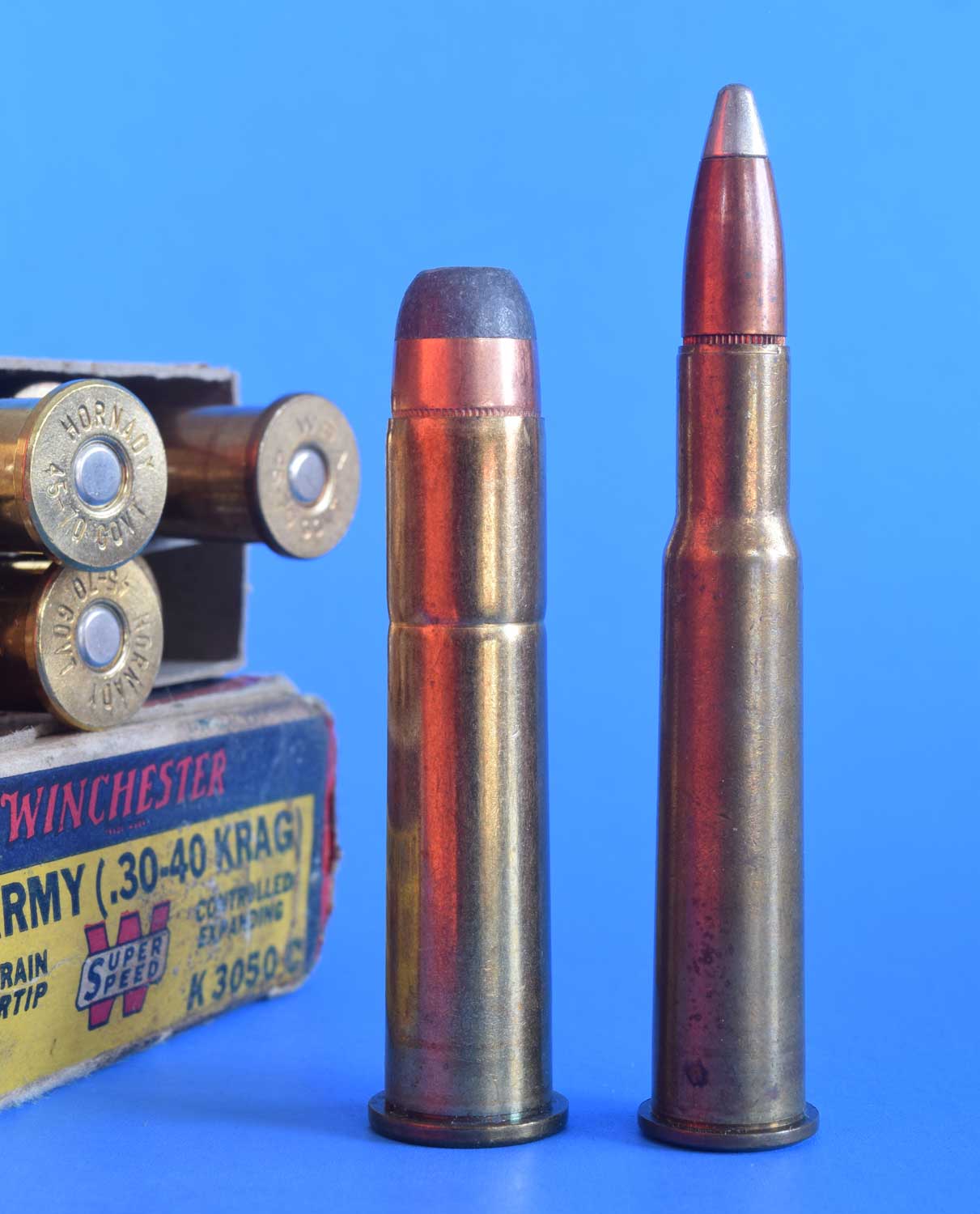
In 1892, the Army replaced the 45-70 with the 30-40 Krag, its first smokeless cartridge, in a bolt rifle.
Its military credentials kept the trapdoor Springfield and its replacement parts in production well past the Army’s 1892 adoption of the Krag-Jorgensen bolt-action rifle and its smokeless 30-40 cartridge.
But not all 45-70s were so fortunate. Sharps rifles had been fashioned to serve buffalo hunters and, to a lesser extent, long-range target shooters. The company had not pivoted to accommodate the fresh demand for lightweight repeaters. An abrupt end to commercial hunting on the plains hurried it toward bankruptcy in 1880. Remington Rolling Block and 1885 Winchester single-shots outlived the costly Sharps, carrying the 45-70 into the smokeless era. Remington-Keene and Winchester-Hotchkiss bolt-actions chambered it, too, as did Winchester’s 1886 and Marlin’s 1895 lever-actions. The 45-70 was one of four cartridges Colt listed for its 1878 double rifle, built to special order from 1879 to 1885. It had Damascus-finished barrels, a fancy checkered walnut stock, case-colored lock plates and hammers. Just 40 are on record as finished. Five years ago, one turned up at auction. It fetched $74,750.
Trapdoor rifles in 45-70 equipped volunteer Spanish-American War regiments in 1898, and state militias later. It also served in the Gatling gun. But it would endure as a hunter’s cartridge in lever rifles.
The 1884 Springfield was still new when John Browning developed for Winchester what would become its elegant Model 1886. Marlin’s equally fine 1895 followed. Both these 45-70 lever rifles would be discontinued—the Marlin in 1915, the Winchester in 1935—as hunters took up with bolt rifles. Marlin revived its 45-70 Model 1895 in 1972; Browning and Winchester paid Miroku of Japan to bring back the 1886 Winchester beginning in its centennial year.
There have been other recent 45-70 rifles. From 1972 to ’86 Harrington & Richardson offered a single-shot Model 171 Springfield Cavalry Carbine in 45-70. Evidently designed to evoke images of the original Springfield, it was not of trapdoor design. Ruger has chambered its No. 1 and No. 3 dropping-block single-shots for the cartridge. The No. 1 was made briefly in 45-70 as a 1-H Tropical Rifle in 1976, as a 1-S Lyman 1878 Centennial rifle in 1978 and as a 1-S 50th-Anniversary model in 1999. As a standard 1-S chambering, it was listed from the start of No. 1 production in 1966 until 2013. The plain Ruger No. 3 Carbine was manufactured from 1972 to ’87. In 1972, Browning introduced its B-78, great grandchild of John Browning’s 1878 rifle that brought him to Winchester’s attention. In 1985, Browning replaced the B-78 with a new 1885 High Wall (the rear wings of the receiver) in several modern chamberings and 45-70. It was dropped in 2004.
The most notable 45-70 these days is of Ruger manufacture but Marlin design—actually, that of brilliant engineer Lewis L. Hepburn, who went to Marlin after financial difficulties at Remington in 1886 ended his 15-year career there. Decades later, after Marlin’s 1969 move to North Haven, Connecticut, the company re-introduced the 1895 rifle in 45-70. It had cut rifling (friendly to cast bullets). Micro-Groove rifling followed, as did a cross-bolt hammer-block safety. A short Guide Gun and the Cowboy with a long octagon barrel were subsequent variants.
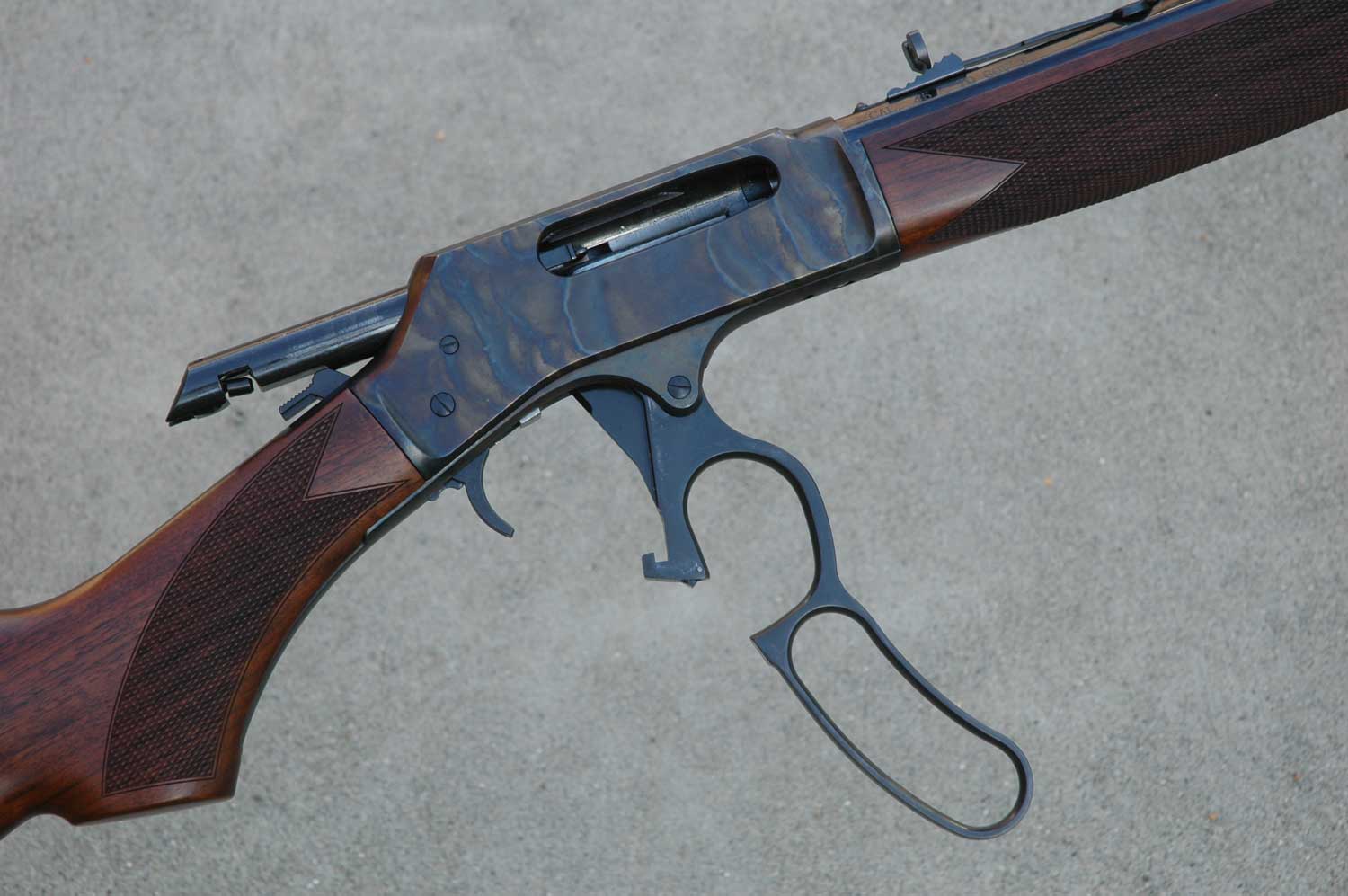
The recent (not the first) Henry lever rifles include this affordable but well-built side-ejecting 45-70.
But appealing rifles aren’t always profitable to make. In fact, the reverse is usually true. Crowded are the cemeteries for brilliantly conceived and beautifully rendered rifles too costly to sell! In December 2007, Marlin was bought by Remington Arms, vassal of an investment house called The Freedom Group. Remington closed Marlin’s H&R plant in Gardner, Massachusetts, in 2008, and two years later shuttered the Marlin works in North Haven, moving production to Ilion, New York. Marlin quality slipped. Said a Remington engineer: “Many of Marlin’s veteran workers chose not to move. Much of the old tooling was worn out or hard to re-install. And Remington had no lever-rifle history. Our learning curve was steep.”
In July 2020, Remington filed for its second Chapter 11 bankruptcy in two years. Alabama Judge Clifton R. Jessup, Jr. later approved the sale of Remington’s non-Marlin firearms business to the Roundhill Group for $13 million. Ruger bought Marlin for $28.3 million, to build traditional Marlin rifles to high quality standards using modern methods.
Ruger CEO Chris Killoy ordered a prompt move to beat winter. Engineers measured tooling for installation in the company’s Mayodan, North Carolina, factory 650 miles away, then organized extraction of 40,000-pound loads. Ruger’s team completed a two-month job in one. The last load left December 9 as snow came to Ilion. The 150 tractor-trailer loads included 450-odd pallets of rough parts. At its new digs, Marlin was given a 105×180-foot cell that would bring rifle components through 53 steps in a production loop. Bruce Rozum, whom I knew when he headed R&D at Marlin, had moved to Ruger’s Newport, New Hampshire, shop as chief engineer. He used North Haven’s auto-CAD drawings to plan CNC operations that would hold tolerances of .002-inch on a rifle 125 years old.
Clearly the first rifle, a 45-70 dubbed the SBL (stainless, big loop) had a Marlin profile. But why the 1895? “There’s renewed interest in 45-70s now,” says Product Manager Eric Lundgren. He conceded the Model 336 in 30-30 had been Marlin’s top seller since its 1948 debut. “But we don’t want Mayodan’s first Marlin to seem ordinary.”
The project required many tweaks in design, tooling and processes. Automation figures heavily in SBL manufacture. No hammers, files or manual screwdrivers are required in its assembly. “We’d planned to ship Marlins by the end of 2021,” says Mark Gurney, Ruger’s director, product management. After thousands of rounds of testing, the first rifle was boxed September 30. A sample SBL reached me a few months later.
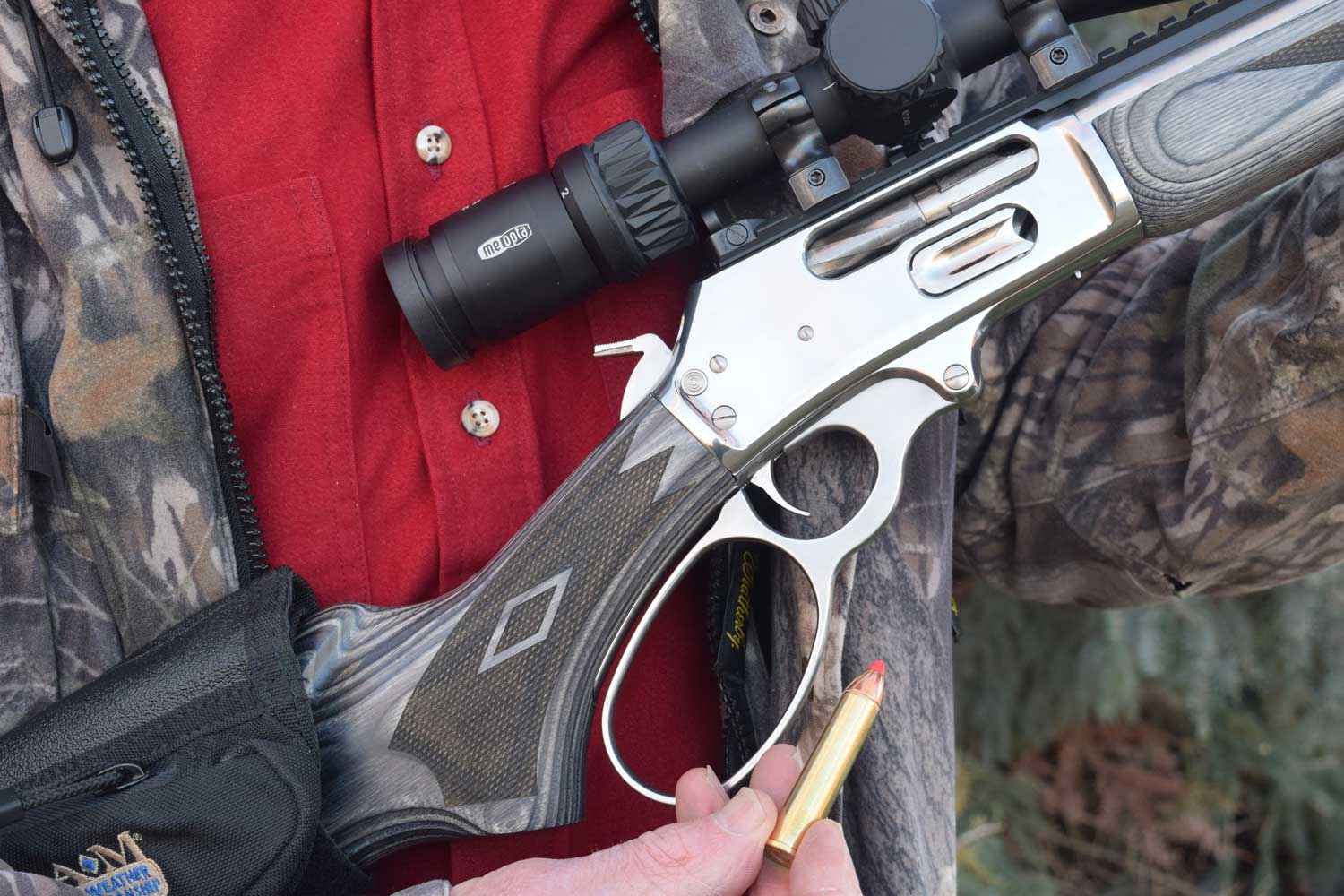
The stainless Marlin 45-70 SBL by Ruger, with departures from the Model 1895, is beautifully built.
Details distinguish it from the original 1895. Its gray laminated stock cradles stainless steel. The oversize lever loop welcomes mittens. A Picatinny rail noses 7 inches up the threaded 19-inch barrel. An adjustable HiViz ghost ring sight pairs with a green tritium-ringed fiber optic rod in a blade atop a beefy ramp up front. The 1:20-inch rifling is hammer-forged. A six-shot magazine is dove-tailed to the barrel behind the muzzle. Forend dimensions yield a comfortable compromise between skinny carbine wood and “hand-filling” fore-stocks. It’s capped, with a swivel stud. Clean point-pattern checkering improves grip during wet weather and in recoil. Crisp, well-proportioned comb fluting, lost at Remington, has been restored. Stocks are shaped and finished at Newport, then shipped to Mayodan. But wood joins metal as snugly as if hand-fitted. Remarkable! I’m impressed, too, by the receiver’s polish. Ripples and dished screw holes show clearly on bright surfaces. A flat finish is hard to achieve, but this Marlin has it!
Trigger pull is spec’d at 5 to 7 pounds. My sample’s breaks cleanly at just over 7. The crossbolt safety is…well, expected.
Cosmetic details include a new “RM” serial number prefix, a fluted, nickeled bolt, a red center in the Marlin bullseye on buttstock’s belly. In lieu of a grip cap, Ruger laser-engraved Marlin’s horse-and-rider logo, part of Frederick Remington’s 1890 painting, Danger Ahead. (John Marlin got permission to use this image, initially on the cover of Marlin’s 1900 catalog.)
Before benching the SBL, I added a Meopta Optika5 2-10×42 scope. In medium rings the 1-inch tube clears the ghost ring sight. There’s 1/8 inch between the front bell and the rail. In my view the rifle’s comb is too low even for “iron” sights. My scope lifts sight-line 3/4 inch. A pad on the comb serves both.
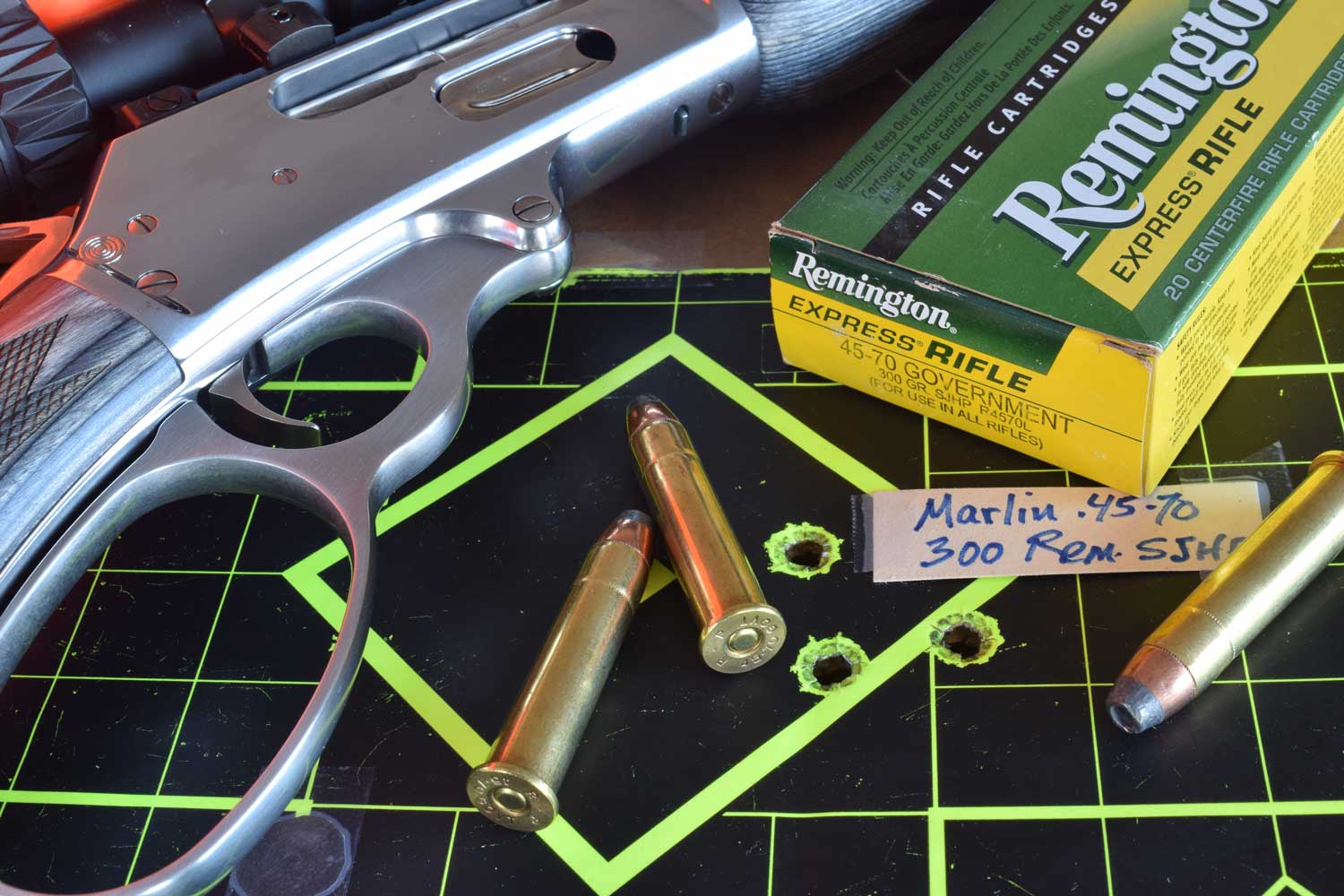
The SBL proved accurate with a range of effective 45-70 hunting loads of mid-level breech pressures.
A 45-70 factory load old as I am gently coughed up a 405-grain bullet. Sharper kick came from Hornady 325-grain FTXs at 2,000 fps, Remington 300-grain semi-jacketed HPs at 1,900 and Black Hills 325-grain Honey Badgers at 1,775. Excepting the 405-grain load, three-shot groups averaged just over an inch, the FTXs cutting a 3/4-inch cloverleaf. The 1-inch recoil pad kept shooting comfortable.
This rifle doesn’t rattle. The action runs piston-slick. It feeds, extracts and ejects with no hitches or loose spots. Thank Ruger’s attention to “stacking,” or summing of tolerances. Tumbling parts removes burrs and produces smooth, uniform surfaces. It’s a Marlin worthy of the brand!
The next Marlins at this writing are also 45-70s. The Trapper is a short-barreled SBL. The Guide Gun is the SBL in blued chrome-moly steel with a brown laminate stock.
Hunters accustomed to scoped bolt rifles hurling bullets at greater than Mach 3 might dismiss the 45-70 as old, irrelevant and ineffective. Well, it is aging. Relevance depends on point of view. I find traditional lever rifles and their cartridges enchanting! Ineffective? Hardly! While my kills with this round are few, and limited to deer, elk and a bison, the 45-70 has proven itself on tougher game. With the right load, it’s as lethal on heavy African beasts as are traditional British big-bores!
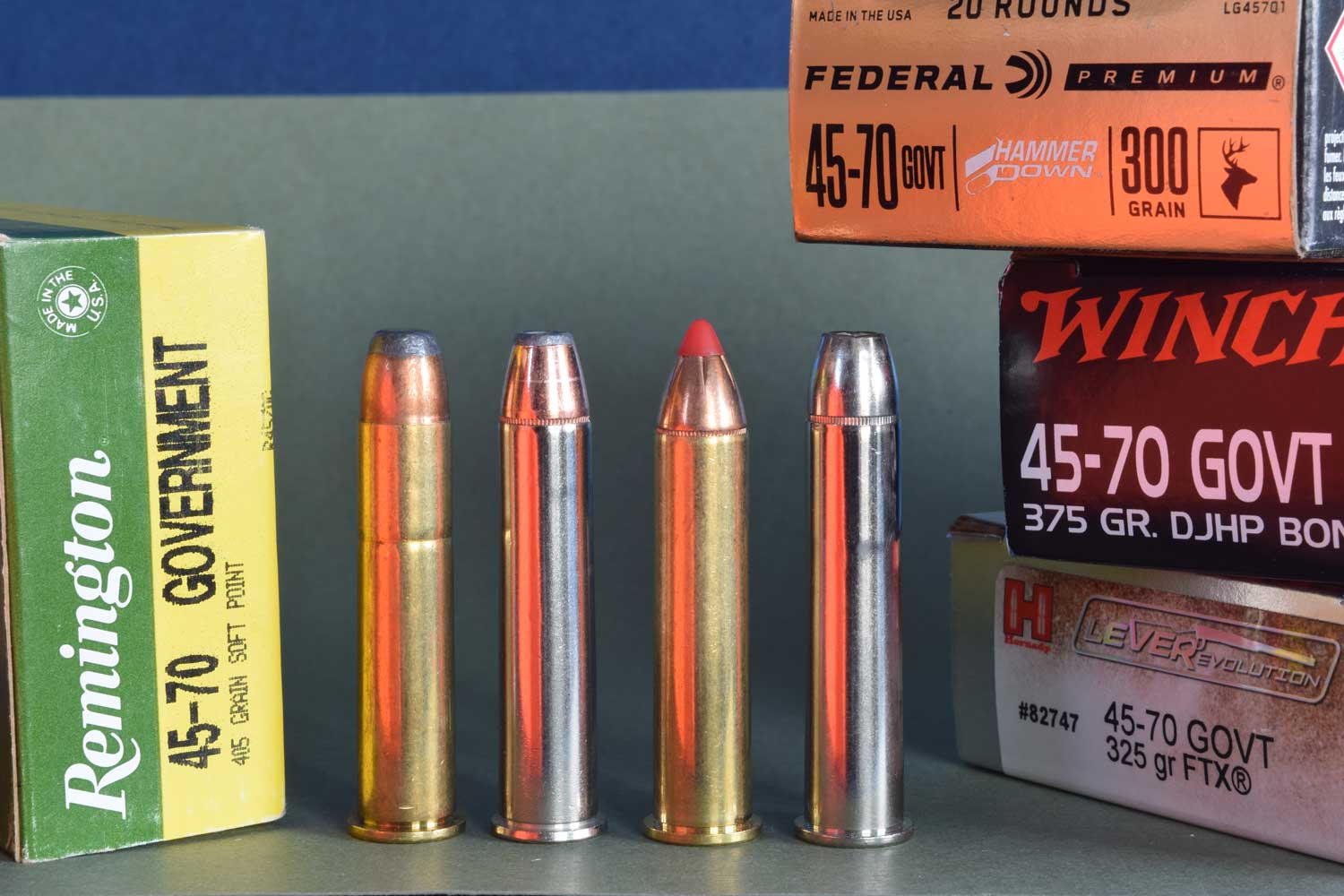
Standard 405-grain loads (1,300 fps, left) are giving way to deadlier hunting options in modern rifles.
The anemic ballistic record of 45-70 ammo comes from loads safe in trapdoor Springfields, with its low tolerance for pressures much over the 25,000 CUP or 28,000 psi of traditional factory ammunition. Such loads work fine (and pamper shooters) in Cowboy Action events, also for hunting when a 405-grain bullet at 1,300 fps is sufficient. Black Hills lists a 405-grain lead flat-nose at 1,250 fps. Winchester has a similar bullet at 1,150, Hornady a sub-sonic jacketed 410-grain at 1,075. Barnes serves handloaders with a 400-grain flat-nose softpoint.
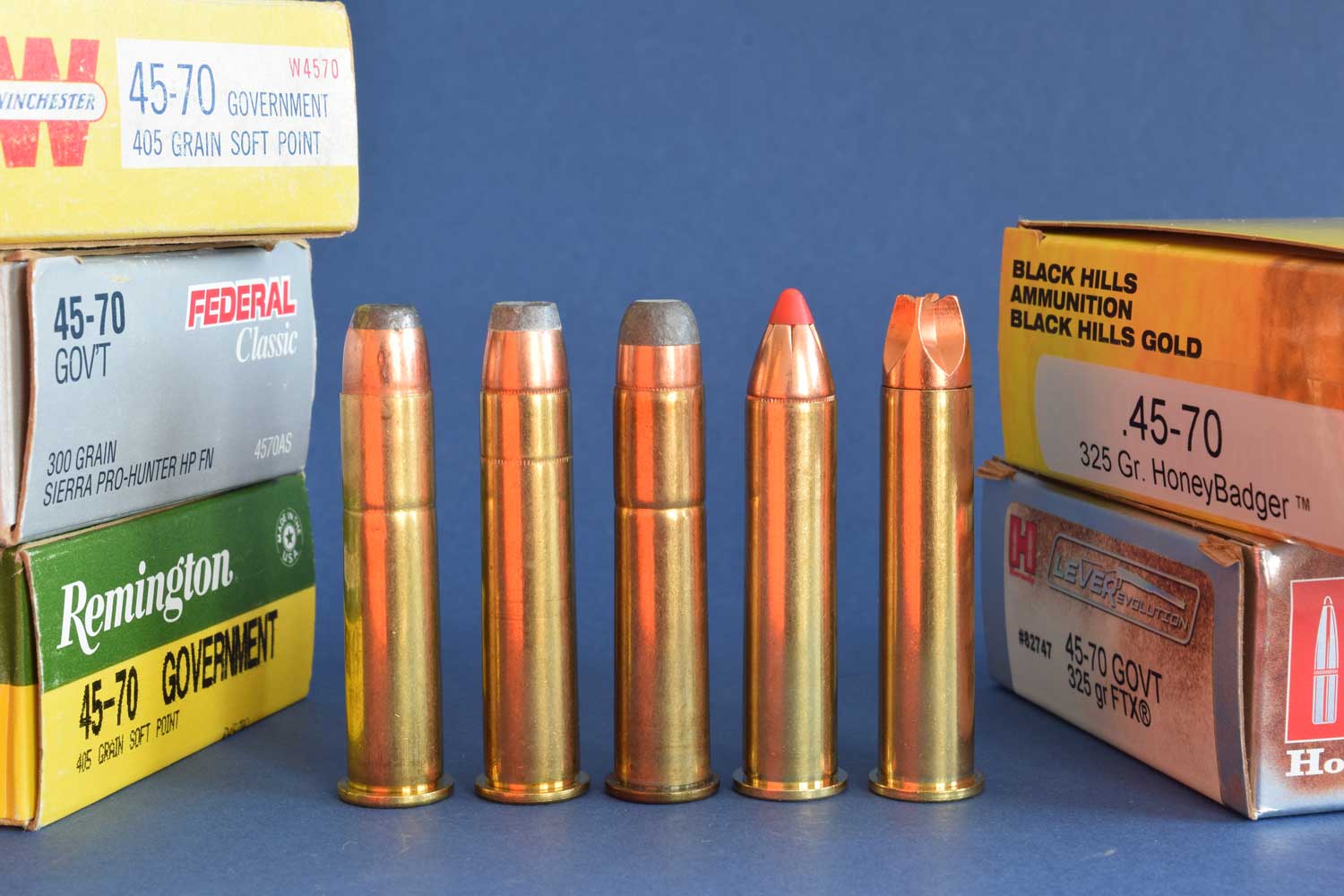
Myriad 45-70 factory loads, with 250- to 500-grain bullets, match breech pressures to a range of rifles.
Two other “classes” of 45-70 loads offer more moxy. In rifles like modern 1895 Marlins and the SBL, built to brook 40,000 CUP, 400-grain bullets can be sent as fast as 1,800 fps. Factory loads from Remington, Winchester and Federal launch 300-grain bullets at up to 1,900 fps. Black Hills pushes deep-driving 325-grain Honey Badgers to 1,775. Hornady claims 2,000 fps from frothy 325-grain FTX loads.
Modern 45-70 brass handles pressures typically reserved for stout single-shot rifles such as Ruger’s No. 1 and No. 3, and remakes of Winchester’s 1885. Figure a ceiling of 50,000 CUP. The Nosler manual shows handloaded 300-grain bullets at 2,200 fps. Swift and Hornady provide data for 350-grain softpoints at more than 2,100. The Barnes manual has 400-grain bullets at 1,900. Naturally, you’ll pick bullets designed for projected impact speeds.
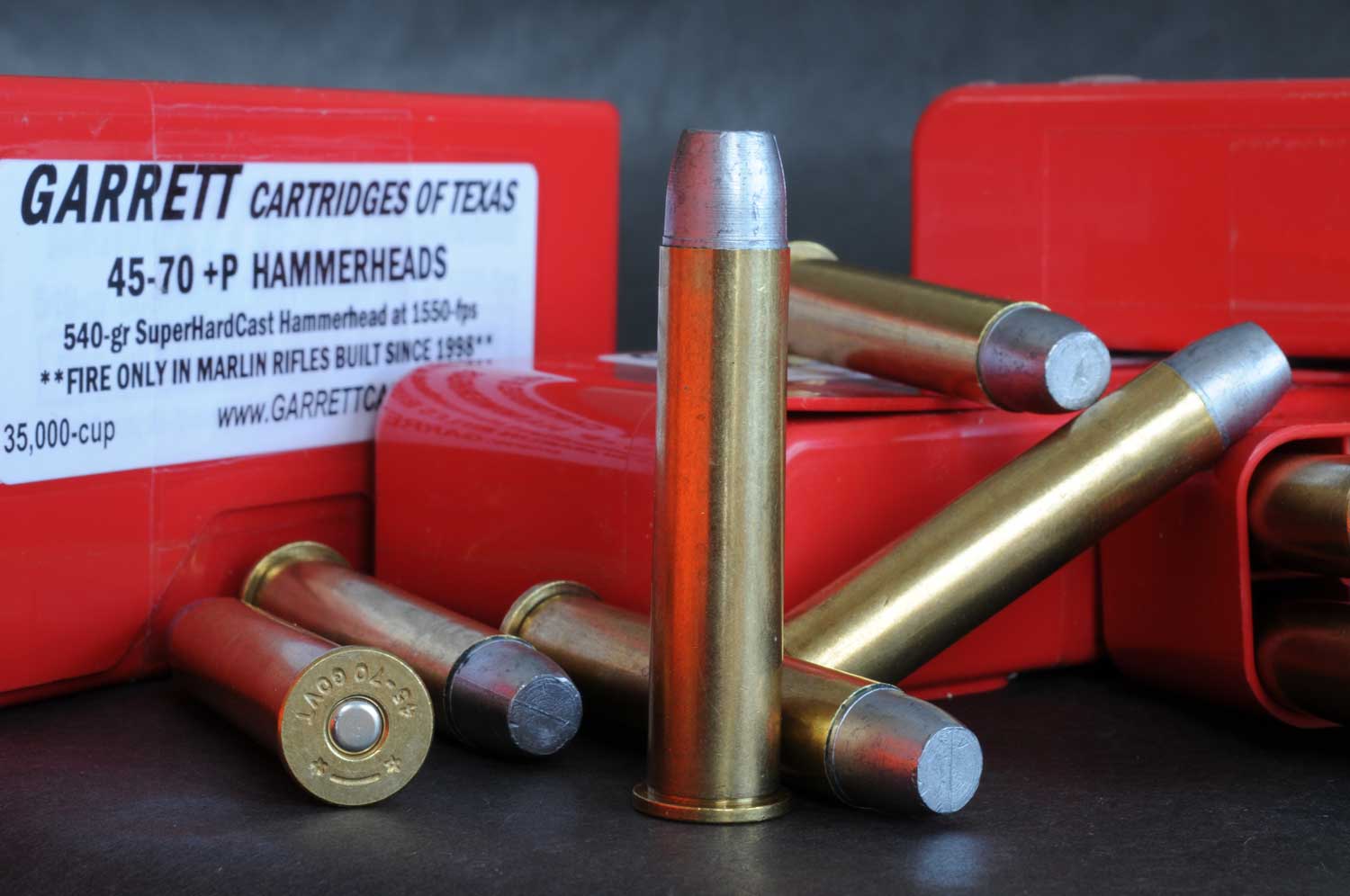
Garrett’s excellent hunting loads are labeled with velocities, breech pressures, rifle recommendations.
Handloads to take heavy animals include 500-grain Hornady DGX and DGS bullets at 1,700 fps. But such power (for stout rifles only!) is also available in factory ammo from Buffalo Bore. It lists 350-grain and 405-jacketed flat-nose bullets loaded to 2,145 and 2,002 fps. Its 430-grain hard-cast bullets at 1,920 fps and 500-grain Barnes Buster solids at 1,628 are “stopping” loads. Grizzly Cartridge also offers haymaker thump, with a 405-grain load at 2,100 fps. It brings nearly 2 tons of energy to the muzzle. Or choose 420- or 460-grain hard-lead gas-check bullets at 2,000 and 1,850 fps. Buffalo and Grizzly both list trapdoor and Cowboy Action loads, too. Garrett 45-70 hunting cartridges with hard-cast bullets come in plastic boxes labeled with breech pressures and rifle recommendations.
Recoil can affect your choice of load. I can’t think of a cartridge with a wider spectrum of recoil energy! A 45-70 load sending 405-grain bullets at 1,300 fps from a 7-pound rifle delivers about 19 ft.-lbs., same as a 308 Winchester load with 165-grain bullets at 2,700 fps. But a 350-grain bullet at 1,900 fps hikes that 45-70’s kick to 38 ft.-lbs.—about what you’ll endure firing 300-grain bullets at 2,500 fps from an 8 1/2- pound .375 H&H Magnum! Buffalo Bore and Grizzly loads with 400- to 420-grain bullets at more than 2,000 fps kick like a 458 Winchester Magnum, dumping 42 ft.-lbs. on your clavicle. Of course, recoil speed also affects what you feel. So does stock design. Mercifully, low, sharp combs and steel crescent butts are going the way of ice-houses and vacuum-driven windshield wipers.
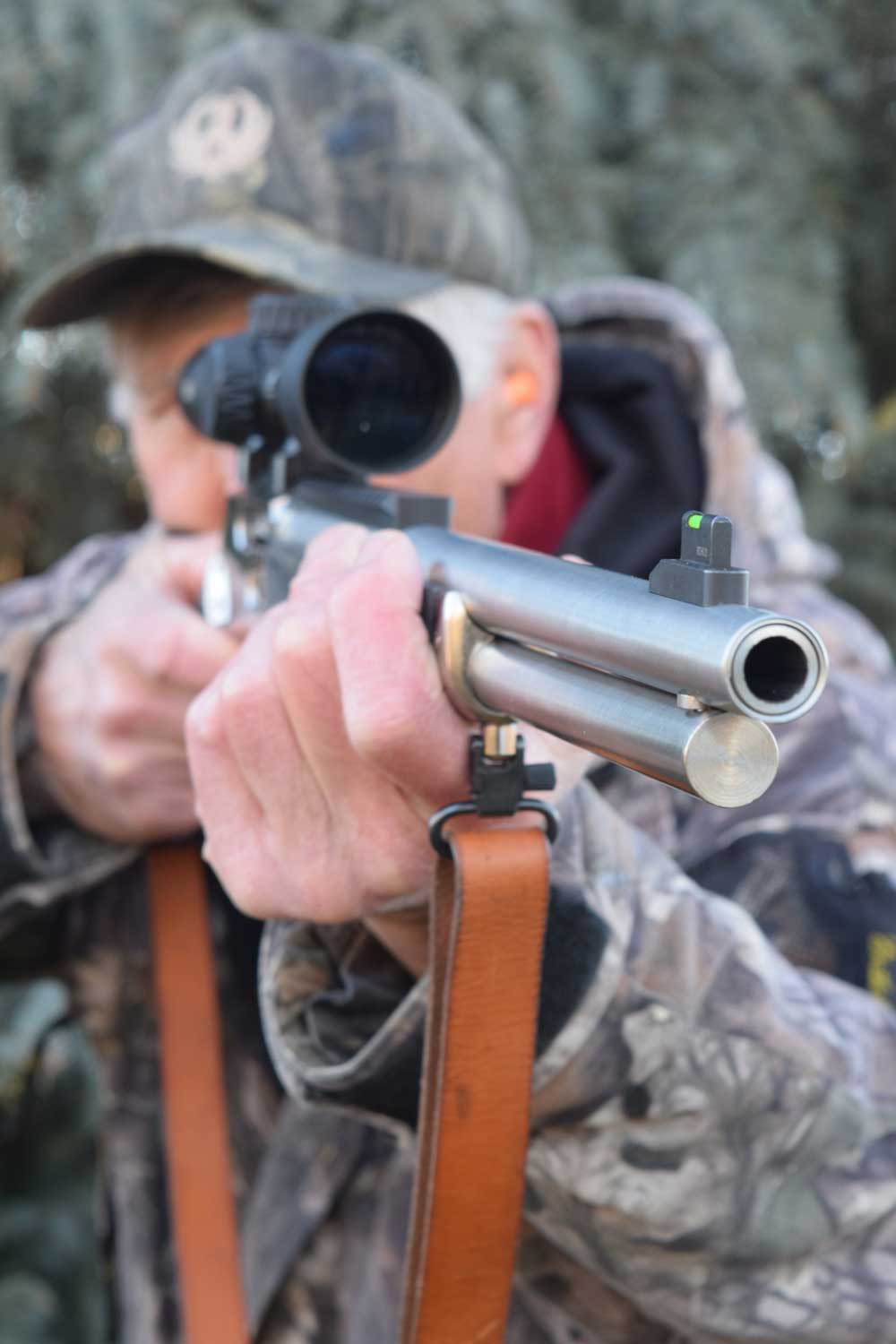
Wayne finds the Marlin SBL quick on target and smooth to cycle. It’s front sight and threaded muzzle are modern departures from Marlin’s 1895, its prototype.
Many Octobers ago, I bellied toward a bright mustard aspen copse gently aflutter under blue skies. As its shade closed over me, the leaves hung limp. My scent no longer drifted. It pooled. A detonation of limbs jerked me to my feet, thumb on the hammer. A riot of elk booming, cracking all around, suddenly became a cataract thundering through a gap below. An antler winked. My bullet flew wide. The Marlin cycled itself. His ribs crossed the sight again. The next bullet caught them. At the 45-70’s third blast the cataract stopped. The copse was empty. The bull lay still.
Perhaps because this and other hunts with 45-70 rifles have pulled me into cover close to game, I’m sweet on this cartridge. It doesn’t reward lazy. But neither does it insist you buy an expensive scope, carry a rangefinder, smart phone with a ballistics app or endure the bite of a bipod on the carry.
Despite its age, the 45-70 is still capable—more so than a recruit with a Springfield in the 1870s could have imagined. And lever rifles so chambered have a pick-me-up appeal shared by few bolt-actions.
A hunter cradling a big-bore lever rifle on a game trail isn’t handicapped. He, or she, is blessed!

